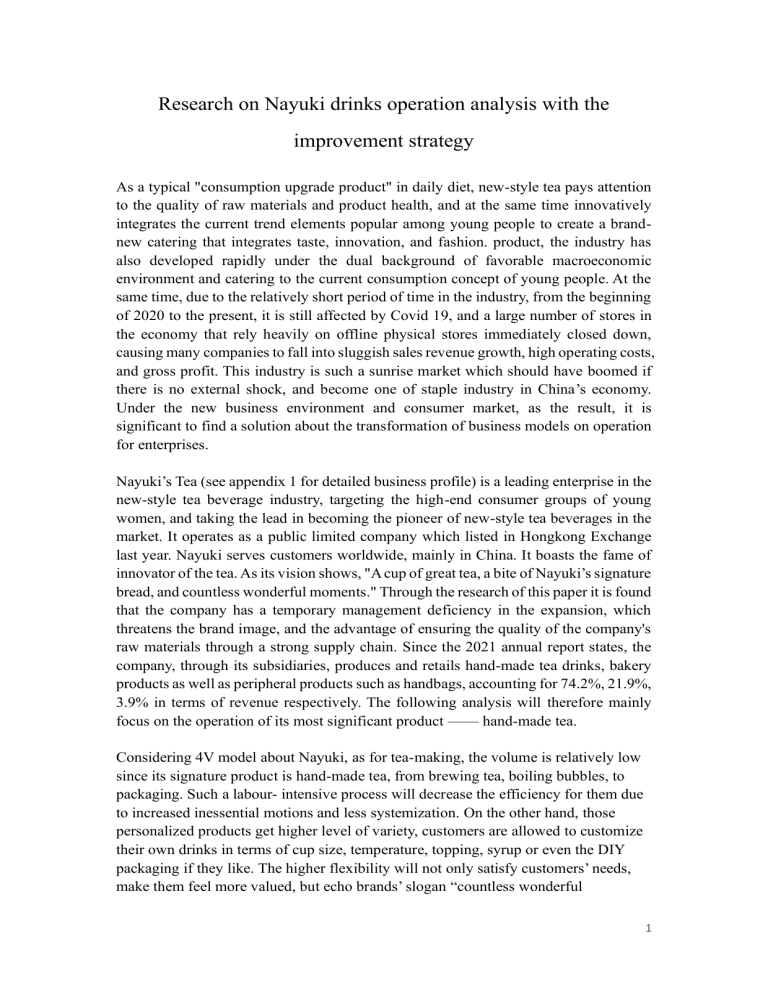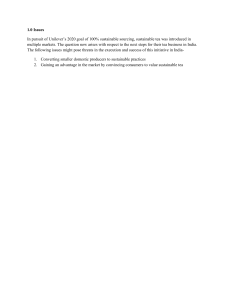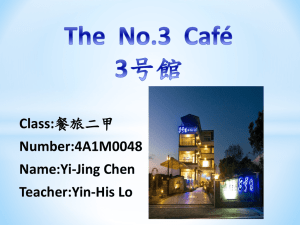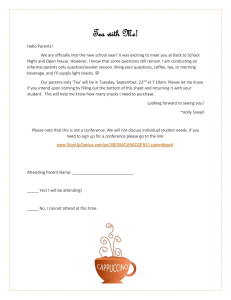
Research on Nayuki drinks operation analysis with the improvement strategy As a typical "consumption upgrade product" in daily diet, new-style tea pays attention to the quality of raw materials and product health, and at the same time innovatively integrates the current trend elements popular among young people to create a brandnew catering that integrates taste, innovation, and fashion. product, the industry has also developed rapidly under the dual background of favorable macroeconomic environment and catering to the current consumption concept of young people. At the same time, due to the relatively short period of time in the industry, from the beginning of 2020 to the present, it is still affected by Covid 19, and a large number of stores in the economy that rely heavily on offline physical stores immediately closed down, causing many companies to fall into sluggish sales revenue growth, high operating costs, and gross profit. This industry is such a sunrise market which should have boomed if there is no external shock, and become one of staple industry in China’s economy. Under the new business environment and consumer market, as the result, it is significant to find a solution about the transformation of business models on operation for enterprises. Nayuki’s Tea (see appendix 1 for detailed business profile) is a leading enterprise in the new-style tea beverage industry, targeting the high-end consumer groups of young women, and taking the lead in becoming the pioneer of new-style tea beverages in the market. It operates as a public limited company which listed in Hongkong Exchange last year. Nayuki serves customers worldwide, mainly in China. It boasts the fame of innovator of the tea. As its vision shows, "A cup of great tea, a bite of Nayuki’s signature bread, and countless wonderful moments." Through the research of this paper it is found that the company has a temporary management deficiency in the expansion, which threatens the brand image, and the advantage of ensuring the quality of the company's raw materials through a strong supply chain. Since the 2021 annual report states, the company, through its subsidiaries, produces and retails hand-made tea drinks, bakery products as well as peripheral products such as handbags, accounting for 74.2%, 21.9%, 3.9% in terms of revenue respectively. The following analysis will therefore mainly focus on the operation of its most significant product —— hand-made tea. Considering 4V model about Nayuki, as for tea-making, the volume is relatively low since its signature product is hand-made tea, from brewing tea, boiling bubbles, to packaging. Such a labour- intensive process will decrease the efficiency for them due to increased inessential motions and less systemization. On the other hand, those personalized products get higher level of variety, customers are allowed to customize their own drinks in terms of cup size, temperature, topping, syrup or even the DIY packaging if they like. The higher flexibility will not only satisfy customers’ needs, make them feel more valued, but echo brands’ slogan “countless wonderful 1 moments”. The third aspect is variation in demand, Nayuki gets the medium high level, mainly resulting from seasonal fluctuation. Its prospectus in 2020 states that in order to forecast the demand for their products more accurately and valid, they invite professional marketing panel to do annual quantitative analysis including time series analysis and moving-average method to identify and apply the seasonal variation to predictions. It turns out that, normally, the sales of tea in summer are higher than that in winter, and the sales revenue in winter is one third of that in summer, since lower temperature will decrease perspiration and further the desire for liquid. In addition, many types of fresh fruit tea such as one of its most popular products named “supreme passion fruit” can only made with ice, limited choices with hot drinks will curb the consumption in freezing weather as well. Being visible to customers and making tea face to face is one of the unique selling points for Nayuki. This contributes to hearing final customers’ voice faster, meanwhile, it effectively shorts waiting tolerance for customers, since they perceive all staff are busy at completing their orders, they directly experience most of the ‘value-adding’ activities. All this goes against lean production and possible higher waste will further rise the unit costs. According to diagram 1, the process step from checking the raw material to the sales to final customers of Nayuki is shown. In order to get and keep fresh raw materials such as seasonal fruits, juices, normally, each store will check them at the end of opening hours every day, and then directly give feedback to the stock or procurement centers, asking for next day’s inventory. It takes about 3 days for transport those perishable materials, and 36 days for packaging materials form central warehouses which locates nearest to the store. Noticeable, fresh fruits are easy to be damaged and deteriorated during transportation even they are kept in cold storage. Or tea cups and paper bags may be out of dated if there is a change in trend or hot spot once they reach, for example, some drinks have designed and launched special and limited packaging with regard to Qatar World Cup recently, so did Nayuki. However, the launch time for them is too late to catch up its rivals. It does not organize pre-sale, and also the launch of their limited packaging and some other peripheral products are near two weeks later than its competitors. The main problem is because of the unreliable and delay delivery. After receiving the raw materials, they are splited into 2 store condition in terms of durability. Perishable items such as milk are stored in refrigerates while others such as tea leaves are stored at normal temperatures, followed by using them for on-site production. This, to some extent, may increase the operation costs due to over-inspection and managerial duplicates. As the result, better logistic system accompanied by more accurate demand forecasting is needed to avoid wastes. 2 Diagram 1: Process map of making fresh-made tea drinks Recent literature illustrates that dining facilities, such as café, carry a high labor cost (Kim, Jang & Shawn, 2020). In such cases, capacity decisions are made from various strategic perspectives, since labor costs affect profitability (Adenso-Díaz, GonzálezTorre, & García, 2002). Nayuki currently capacity management is feasible and effective. It adopts mix strategies to maximize the utilization of its own capacity. First of all, in order to cope with variants in demand, price discrimination is employed in this business. For example, it devises special offers to allow for bulk-purchasing discounts. As shown in its mini takeaway platform, customers can get 30% discounts if they buy 2 cups of tea and 2 bread as a combo. Or if customers consume in-store from 10:00 a.m. to 5:30 p.m. on working day, they could also get 5% discount as the reward of avoiding over-crowded. In addition, it organizes below-the line promotional 3 activity to increase demand in off-peak periods, such as free coupon or buy one get one free in specific winter day. On the other side, it also directly closes the online order platform if there is a busy-time such as weekend, so consumers cannot preorder or the staff may negotiate delivery time with customers, if they do want to order, there is an expectation of expected longer waiting time told by staff so that it helps to restrict services indirectly. Therefore, based on different price elasticity of consumers, all these measures will help it to balance the demand in different periods, cooling over-heated consumption, nudging and attracting some customers to consume during slack time. Nayuki also meanwhile get chase capacity plan to adjust capacity in responsive to the fluctuation of demand. Besides over-time working during peak time, workforce planning does contribute the capacity management in supply side. As shown in the annual report in 2021, 30% of its employees are with temporary or zerohour contracts, this allows the business to be more flexible to manage peak season such as summer holiday. Also, more staff are available to be called, if there be sickness or absenteeism, or just for demand surges. Moreover, the opening hour adjustment also indicates that in order to meet the higher demand in peak season (usually from April to October plus Chinese spring festival holiday in January), most stores will open early and stay open longer from 9:00 a.m. to 10:30 p.m. compares with that in winter from 10:00 a.m. to 9:30 p.m. Even if Nayuki has already proved to be one of the top businesses in Chinese drinking industry, there are still excess capacity it could exploited if improved capacity management plan is introduced. Firstly, level capacity can be considered, keeping manufacturing of basic food materials as close to ‘level’ as possible, and ignoring demand fluctuations. Nayuki should focus on maximum utilization, for example, consumers queueing moment. Some studies suggest that the management of queues using technological innovations, such as online-based ordering and self-service kiosks, can reduce long customer lines (Dixon et al., 2009; Ramasamy et al., 2018). In particular, a cloud-based method to automatically manage the queues of casual dining facilities was explored by Ramasamy et al. (2018), where the customers were allowed to reserve their spot in the queue without being present at the facility. They posited that the proposed system would enable the customers to be served within 10 min of entering the facility. Besides reducing the customer wait time, queue management technologies can also improve their overall experience (Dixon et al., 2009). As the result, Nayuki should have got a strong online booking system. As shown in its 2021 annual report, 35% of its sales revenue generated from customer orders placed through our WeChat and Alipay mini programs and Nayuki app. However, it meanwhile gains increased customers’ dissatisfaction and negative publicity on highly-frequent application crashes which makes inconvenient for customers and further falls in sales. Some customers complains that “the mini program is too weak to support their basic order needs, probably the internal IT staff do not receive a fair remunerate, this is why their platform is such a useless application”. Another method is to make best-sellers in advance when staff are relatively slack such as early in the morning, and store and refrigerate them in cans, so that it contributes utilize staff 4 better to meet the surged temporary demand since they do not need to spend extra time on making the products once order receive. However, Nayuki is required to convince the customers that the quality of prepared canned drinks is the same as the freshly-made ones, it takes time to change their perceptions as “make-to-order” product is the most important unique selling point for Nayuki. Meanwhile, this innovator has to do data collections and analysis if it adopts AI system. Ali K. Dogru (2021) suggests artificial intelligence is widely used in current retail operations. Web-based shopping enables retailers to collect vast amounts of data regarding shopping habits, basket composition, and even browsing patterns. These data provide information regarding future offerings, promotions, and help retailers manage their supply chain operations, inventory fulfillment, and distribution systems. Based on AI analysis, Nayuki could forecast the possible “right” amount of demand more accurately. Through big data analysis of consumers' consumption behavior, it can grasp consumers' consumption preferences, as well as the catering characteristics and laws of the entire consumer group. Be able to respond timely and according to big data analysis results. Despite AI immense benefits, this to some extent conflicts with lean production since it increases waste by storing Inventory in excess of immediate needs. Besides, AI applications currently operate in the grey legal area that has not been regulated well. Inadequate regulation creates an asymmetric environment, in which Nayuki might be incentivized to accelerate deployment of AI technologies while spending minimal time for tests that are vital to protect consumers from information disclosure. This not only does the business increase research and develop costs, but also leads to customers’ untrust and an unethical image, further cuts its profit margin. In post-pandemic era, a dramatic increased unemployment rate in China and a reduction in purchasing power of customers due to inflation hits the whole retailing industry, as consumers tend to be more cautious towards travel and consumption with the recurrence of the COVID-19 pandemic. Especially when the corresponding public health control measures tightened in various regions when the Omicron variant emerged in Mainland China in the second half of 2021, which brought challenges to Nayuki’s financial performance. Specifically, in 2021, the Group’s revenue increased by approximately 40.5% to RMB4,296.6 million from RMB3,057.2 million in 2020, and the adjusted net profit/(loss) turned from profit of RMB16.6 million in 2020 to loss of RMB145.3 million in 2021. The reason is that increased energy crisis caused by Russia's war in Ukraine leads to higher logistic costs. And internally, as of December 31, 2021, the inventories of the Group amounted to RMB174.1 million (as of December 31, 2020: RMB103.1 million). The increase in the Group’s inventories was primarily due to raised stock, however, it is noticed that write-down of inventories goes up to 1.6 million (2021) from 0.6 million (2020), indicating the of waste on raw materials including dairy products, seasonal fruit and on cost of packaging material such as tea cups and paper bags might be the culprit of its loss. Therefore, it is necessary for Nayuki to adopt the philosophy of lean production. Krisztina Demeter (2010) states that companies that implement lean practices in 5 manufacturing have significantly better inventory turnover for each type of inventory (RM, WIP and FG) than do traditional companies. The Group’s inventories turnover days increased from 28.5 days for 2020 to 36.1 days for the Reporting Period. Lean companies keep fewer inventories of any type. By the practice of lean production, Nayuki will maintain the flexibility of production while improving resource utilization (Chase et al, 2006) by prolonging the turnover rate. As the result, firstly, the business could keep minimum level of inventory to avoid risks, this requires reliable suppliers with no delay delivering when needed, so just-intime system could be applied once they get trusted upstream companies. This requires an advanced ERP system based on timely information of supply chain management. In particular, each store of the business collects customer information about their demand, through the customer-based store system, and transmits the customer demand information to the operation decision-making system of the headquarters after sorting. The operation decision-making system of the headquarters will feed back the information to the corresponding departments through the supplier-based procurement system, so that the procurement department can make a reasonable demand plan. Then, the purchase order is issued through the collected relevant information, and the information is exchanged with the supplier through the system. The logistics management department shall check the warehousing situation and the demand plan of outlet stores fed back by the headquarters in real time through the logistics management system based on distribution and transportation, and timely arrange material distribution. This system might be very help in the distribution of perishable raw materials such as fresh fruits and daily milk. In addition, considering backward vertical integration is an alternative, so that it ensures the quantity and security of supplies and possibly reduces the costs of supplies. In 2021, the Group’s largest supplier accounted for 10.39% of the Group’s total purchase. And the Group’s five largest suppliers accounted for 29.80% of the Group’s total purchase, this shows that Nayuki may be over reliant on those suppliers, leading to lower bargaining power. Or it is advisable for Nayuki to develop its own supplier chain from the very first stage such as raising cows on its own pasture to provide dairy products, or growing exclusive tea plantation in order to get the fresh tea leaves. Secondly, since the most consumers complaints are about too long waiting time, and for delivery not arriving as promised (See appendix 2 for detailed complaints), it is urgent for the group to decrease motion of the staff. The fresh-tea making process is based on piece rate with independent individuals, which means, there will be only one staff who serves the customers from the ordering, the making, till the delivering. They will always get into each other’s ways to finish more pieces with unstandardized tea. It will be more efficient and productive if the whole store could produce with division of labors and arranges different employees within the same stores to finish different tasks, since decrease the time between different tasks will presents a more professional and well-organized image. Also, the defect rate might decrease as specialized staff may be more skilled due to repetitive work, further leads to eliminate 6 unnecessary excess production, includes any form of inspection to avoid non-value add activity such as over-processing. In conclusion, since early 2022, a new wave of COVID-19 outbreak has impacted various regions across Mainland Chinese with raising reported confirmed cases. The Chinese government has imposed various restrictions over business activities, including temporarily banning of dine-in services and reduced business hours in certain areas where the confirmed cases are high. From 2020 to 2022, more than 60% milk-tea shops have left the market due to limited revenue stream. The impact to the operation of the Group remains highly uncertain and subject to the development of the situation. Introducing lean production in the long run will definitely benefit the group, however, in the short run, the high set-up costs on information system or professional training of staff may result in a huge cash outflow at the same time. Potential liquidity problem could occur which makes it harder for Nayuki to survive at the moment. Therefore, a more conservative strategy rather than aggressive expansion and overexcessive on research and development might be more appropriate for the group in 2022 considering its main market is extremely shocked by external factors such as political or economic influence, which is out of control by Nayuki itself even if it has a better operation management. 7 References Achabal, D.D. et al. (2000) ‘A decision support system for vendor managed inventory’, Journal of Retailing, 76(4), pp. 430–454. Available at: https://doi.org/10.1016/S0022-4359(00)00037-3. Apte, U.M., Karmarkar, U.S. and Pitbladdo, R. (1997) ‘Quality Management in Services: Analysis and Measurement’, in P.J. Lederer and U.S. Karmarkar (eds) The Practice of Quality Management. Boston, MA: Springer US, pp. 167–193. Available at: https://doi.org/10.1007/978-1-4615-6283-2_7. Christopher, M. (1999) Logistics & Supply Chain Management, Second Edition: Strategies for Reducing Costs and Improving Service. 2nd Edition, 5th Printing. London: Financial Times/Prentice Hall. Demeter, K. and Matyusz, Z. (2011) ‘The impact of lean practices on inventory turnover’, International Journal of Production Economics, 133(1), pp. 154–163. Available at: https://doi.org/10.1016/j.ijpe.2009.10.031. Dogru, A.K. and Keskin, B.B. (2020) ‘AI in operations management: applications, challenges and opportunities’, Journal of Data, Information and Management, 2(2), pp. 67–74. Available at: https://doi.org/10.1007/s42488-020-00023-1. Gimenez, C. and Ventura, E. (2005) ‘Logistics‐production, logistics‐marketing and external integration: Their impact on performance’, International Journal of Operations & Production Management, 25(1), pp. 20–38. Available at: https://doi.org/10.1108/01443570510572222. Gogoulos, F.I. et al. (2013) ‘An Intelligent Trucking Operations Management System’, IFAC Proceedings Volumes, 46(25), pp. 49–54. Available at: https://doi.org/10.3182/20130916-2-TR-4042.00016. Hughes, J., Ralf, M. and Michels, W. (1998) Transform Your Supply Chain: Releasing Value in Business. 1st edition. London ; Boston: Cengage Learning EMEA. Kambli, A., Sinha, A.A. and Srinivas, S. (2020) ‘Improving campus dining operations using capacity and queue management: A simulation-based case study’, Journal of Hospitality and Tourism Management, 43, pp. 62–70. Available at: https://doi.org/10.1016/j.jhtm.2020.02.008. Kleback, C. (2012) ‘Review of Lean Library Management: Eleven Strategies for Reducing Costs and Improving Customer Services’, The Library Quarterly: Information, Community, Policy, 82(2), pp. 237–239. Available at: https://doi.org/10.1086/664579. Lee, H.L., Padmanabhan, V. and Whang, S. (1997) ‘Information Distortion in a Supply Chain: The Bullwhip Effect’, Management Science, 43(4), pp. 546–558. 8 Available at: https://doi.org/10.1287/mnsc.43.4.546. Nayuki Holdings Limited (2022) 2021 Annual Report of Nayuki Holdings Limited, Nayuki Holdings Limited. Available at: https://nayukiumb.azurewebsites.net/media/wdngjae1/2021-annual-report.pdf (Accessed: 27 November 2022). Rubiano Ovalle, O. and Crespo Marquez, A. (2003) ‘The effectiveness of using ecollaboration tools in the supply chain: an assessment study with system dynamics’, Journal of Purchasing and Supply Management, 9(4), pp. 151–163. Available at: https://doi.org/10.1016/S1478-4092(03)00005-0. 9 Appendix 1: Nayuki group profile Nayuki Holdings Ltd is a China-based investment holding company. The Company is principally engaged in the sales of freshly made tea drinks, baked goods and other products. The Company mainly operates two teahouse brandsits flagship brand Nayuki and sub-brand Tai Gai. Nayuki focus on offering a broad array of freshly made tea drinks and handcrafted baked goods. Tai Gai mainly offers a selection of classic milk tea and lemon tea drink. The Company has developed a list of classic and seasonal tea drinks, comprising three major product categories in fruit teas, milk teas and pure teas. In addition, the Company provides a wide selection of other products, such as gift tea boxes, snacks and ready-to-drink tea beverages. The Company distributes its products both in the domestic market and to overseas markets. 10 11 Appendix 2: Customers’ complaints on Nayuki 12






